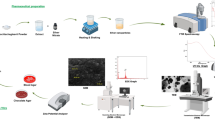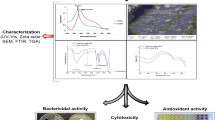Abstract
The present investigation concentrates on the green combination of biosynthesized selenium nanoparticles utilizing aqueous extract of cow urine as a green technique with no external chemicals, reagents, or surfactants. The combination of parameters, for example, the sodium selenite precursor concentration, or the concentration of cow urine extract, time of synthesis, and pH on the particle size of combined selenium particles, was explored and enhanced. The participation of the factors in controlling the particle size of reduced SeNPs was quantitatively evaluated by means of analysis of variance (ANOVA). The UV-Vis spectroscopy was utilized to screen the selenium nanoparticle development followed by electron microscopy (SEM and TEM), DLS, AFM, and EDAX. The optimized nanoparticles were subjected to antibacterial activity against Gram-positive and Gram-negative cultures, out of which the highest activity was observed for Klebsiella sp. The biosynthesized and optimized selenium nanoparticles can be further used for various pharmaceutical or industrial applications.
















Similar content being viewed by others
References
Zonaro, E., Lampis, S., Turner, R. J., Junaid, S., & Vallini, G. (2015). Biogenic selenium and tellurium nanoparticles synthesized by environmental microbial isolates efficaciously inhibit bacterial planktonic cultures and biofilms. Frontiers in Microbiology, 6, 1–11. https://doi.org/10.3389/fmicb.2015.00584.
Ramamurthy, C. H., Sampath, K. S., Arunkumar, P., Kumar, M. S., Sujatha, V., Premkumar, K., & Thirunavukkarasu, C. (2013). Green synthesis and characterization of selenium nanoparticles and its augmented cytotoxicity with doxorubicin on cancer cells. Bioprocess and Biosystems Engineering, 36, 1131–1139. https://doi.org/10.1007/s00449-012-0867-1.
Kumari, M., Purohit, M. P., Patnaik, S., Shukla, Y., Kumar, P., & Gupta, K. C. (2018). Curcumin loaded selenium nanoparticles synergize the anticancer potential of doxorubicin contained in self-assembled, cell receptor-targeted nanoparticles. European Journal of Pharmaceutics and Biopharmaceutics, 130, 185–199. https://doi.org/10.1016/j.ejpb.2018.06.030.
Srivastava, P., Braganca, J. M., & Kowshik, M. (2014). In vivo synthesis of selenium nanoparticles by Halococcus salifodinae BK18 and their anti-proliferative properties against HeLa cell line. Biotechnology Progress, 30, 1480–1487. https://doi.org/10.1002/btpr.1992.
Radhika Rajasree, S. R., & Gayathri, S. (2015). Extracellular biosynthesis of selenium nanoparticles using some species of Lactobacillus. Indian Journal of Geo-Marine Sciences, 43, 766–775.
Yu, B., You, P., Song, M., Zhou, Y., Yu, F., & Zheng, W. (2016). A facile and fast synthetic approach to create selenium nanoparticles with diverse shapes and their antioxidation ability. New Journal of Chemistry, 40, 1118–1123. https://doi.org/10.1039/c5nj02519b.
Mary, T. A., Shanthi, K., Vimala, K., & Soundarapandian, K. (2016). PEG functionalized selenium nanoparticles as a carrier of crocin to achieve anticancer synergism. RSC Advances, 6, 22936–22949. https://doi.org/10.1039/c5ra25109e.
Zhao, G., Wu, X., Chen, P., Zhang, L., Yang, C. S., & Zhang, J. (2018). Selenium nanoparticles are more efficient than sodium selenite in producing reactive oxygen species and hyper-accumulation of selenium nanoparticles in cancer cells generates potent therapeutic effects. Free Radical Biology & Medicine, 126, 55–66. https://doi.org/10.1016/j.freeradbiomed.2018.07.017.
Weekley, C. M., & Harris, H. H. (2013). Which form is that? The importance of selenium speciation and metabolism in the prevention and treatment of disease. Chemical Society Reviews, 42, 8870–8894. https://doi.org/10.1039/c3cs60272a.
Nazıroğlu, M., Muhamad, S., & Pecze, L. (2017). Nanoparticles as potential clinical therapeutic agents in Alzheimer’s disease: focus on selenium nanoparticles. Expert Review of Clinical Pharmacology, 10, 773–782. https://doi.org/10.1080/17512433.2017.1324781.
Atta, A. H., El-shenawy, A. I., Koura, F. A., & Refat, M. S. (2014). Synthesis and characterization of some selenium nanometric compounds : spectroscopic. Biological and Antioxidant Assessments, 58–69.
Jia, X., Liu, Q., Zou, S., Xu, X., & Zhang, L. (2015). Construction of selenium nanoparticles/β-glucan composites for enhancement of the antitumor activity. Carbohydrate Polymers, 117, 434–442. https://doi.org/10.1016/j.carbpol.2014.09.088.
Kokila, K., Elavarasan, N., & Sujatha, V. (2017). Diospyros Montana leaf extract-mediated synthesis of selenium nanoparticles and their biological applications. New Journal of Chemistry, 41, 7481–7490. https://doi.org/10.1039/c7nj01124e.
Liao, W., Yu, Z., Lin, Z., Lei, Z., Ning, Z., Regenstein, J. M., Yang, J., & Ren, J. (2015). Biofunctionalization of selenium nanoparticle with Dictyophora indusiata polysaccharide and its antiproliferative activity through death-receptor and mitochondria-mediated apoptotic pathways. Scientific Reports, 5, 1–13. https://doi.org/10.1038/srep18629.
Lopez Heras, I. (2014). Effect of chitosan-stabilized selenium nanoparticles on cell cycle arrest and invasiveness in hepatocarcinoma cells revealed by quantitative proteomics. Journal of Nanoscience and Nanotechnology, 05. https://doi.org/10.4172/2157-7439.1000226.
Cui, Y. H., Li, L. L., Zhou, N. Q., Liu, J. H., Huang, Q., Wang, H. J., Tian, J., & Yu, H. Q. (2016). In vivo synthesis of nano-selenium by Tetrahymena thermophila SB210. Enzyme and Microbial Technology, 95, 185–191. https://doi.org/10.1016/j.enzmictec.2016.08.017.
Fesharaki, P. J., Nazari, P., Shakibaie, M., Rezaie, S., Banoee, M., Abdollahi, M., & Shahverdi, A. R. (2010). Biosynthesis of selenium nanoparticles using Klebsiella pneumoniae and their recovery by a simple sterilization process. Brazilian Journal of Microbiology, 41, 461–466. https://doi.org/10.1590/S1517-83822010000200028.
Srivastava, P., & Kowshik, M. (2016). Anti-neoplastic selenium nanoparticles from Idiomarina sp. PR58–8. Enzyme and Microbial Technology, 95, 192–200. https://doi.org/10.1016/j.enzmictec.2016.08.002.
Modrzejewska-Sikorska, A., Konował, E., Klapiszewski, Ł., Nowaczyk, G., Jurga, S., Jesionowski, T., & Milczarek, G. (2017). Lignosulfonate-stabilized selenium nanoparticles and their deposition on spherical silica. International Journal of Biological Macromolecules, 103, 403–408. https://doi.org/10.1016/j.ijbiomac.2017.05.083.
Prabhu, M., Mutnuri, S., Dubey, S. K., & Naik, M. M. (2014). One-pot rapid synthesis of face-centered cubic silver nanoparticles using fermented cow urine, a nanoweapon against fungal and bacterial pathogens. Journal of Bionanoscience, 8, 265–273. https://doi.org/10.1166/jbns.2014.1235.
Jain, N., Bhosale, P., Tale, V., Henry, R., & Pawar, J. (2019). Hydrothermal assisted the biological synthesis of silver nanoparticles by using honey and gomutra (Cow urine) for qualitative determination of its antibacterial efficacy against pseudomonas sp.isolated from contact lenses. EurAsian Journal of BioSciences, 13, 27–33.
Randhawa, G., & Sharma, R. (2015). Chemotherapeutic potential of cow urine and uses; a review. Journal of Intercultural Ethnopharmacology, 4, 180. https://doi.org/10.5455/jice.20150222100320.
Skalickova, S., Milosavljevic, V., Cihalova, K., Horky, P., Richtera, L., & Adam, V. (2017). Selenium nanoparticles as a nutritional supplement. Nutrition., 33, 83–90. https://doi.org/10.1016/j.nut.2016.05.001.
Wadhwani, S. A., Shedbalkar, U. U., Singh, R., & Chopade, B. A. (2016). Biogenic selenium nanoparticles: current status and future prospects. Applied Microbiology and Biotechnology, 100, 2555–2566. https://doi.org/10.1007/s00253-016-7300-7.
Chudobova, D., Cihalova, K., Dostalova, S., Ruttkay-Nedecky, B., Merlos Rodrigo, M. A., Tmejova, K., Kopel, P., Nejdl, L., Kudr, J., Gumulec, J., Krizkova, S., Kynicky, J., Kizek, R., & Adam, V. (2014). Comparison of the effects of silver phosphate and selenium nanoparticles on Staphylococcus aureus growth reveals potential for selenium particles to prevent infection. FEMS Microbiology Letters, 351, 195–201. https://doi.org/10.1111/1574-6968.12353.
Dizaj, S. M., Lotfipour, F., Barzegar-Jalali, M., Zarrintan, M. H., & Adibkia, K. (2015). Box-Behnken experimental design for preparation and optimization of ciprofloxacin hydrochloride-loaded CaCO3nanoparticles. Journal of Drug Delivery Science and Technology, 29, 125–131. https://doi.org/10.1016/j.jddst.2015.06.015.
Venugopal, V., Kumar, K. J., Muralidharan, S., Parasuraman, S., Raj, P. V., & Kumar, K. V. (2016). Optimization and in-vivo evaluation of isradipine nanoparticles using Box-Behnken design surface response methodology. OpenNano., 1, 1–15. https://doi.org/10.1016/j.onano.2016.03.002.
Chhabria, S., & Desai, K. (2016). Selenium nanoparticles and their applications. Encyclopedia of Nanoscience and Nanotechnology, 1–32.
Menon, S., Ks, S. D., Santhiya, R., Rajeshkumar, S., & S, V. K. (2018). Selenium nanoparticles: a potent chemotherapeutic agent and an elucidation of its mechanism. Colloids and Surfaces. B, Biointerfaces, 170, 280–292. https://doi.org/10.1016/j.colsurfb.2018.06.006.
Menon, S., Shrudhi, S. D., Agarwal, H., & Shanmugam, V. K. (2019). Efficacy of biogenic selenium nanoparticles from an extract of ginger towards evaluation on anti-microbial and anti-oxidant activities. Colloid and Interface Science Communications, 29, 1–8. https://doi.org/10.1016/j.colcom.2018.12.004.
Kora, A. J., & Rastogi, L. (2016). Biomimetic synthesis of selenium nanoparticles by Pseudomonas aeruginosa ATCC 27853: an approach for conversion of selenite. Journal of Environmental Management, 181, 231–236. https://doi.org/10.1016/j.jenvman.2016.06.029.
Srivastava, N., & Mukhopadhyay, M. (2013). Biosynthesis and structural characterization of selenium nanoparticles mediated by Zooglea ramigera. Powder Technology, 244, 26–29. https://doi.org/10.1016/j.powtec.2013.03.050.
Sharma, G., Sharma, A. R., Bhavesh, R., Park, J., Ganbold, B., Nam, J. S., & Lee, S. S. (2014). Biomolecule-mediated synthesis of selenium nanoparticles using dried Vitis vinifera (raisin) extract. Molecules., 19, 2761–2770. https://doi.org/10.3390/molecules19032761.
Rajeshkumar, S., Malarkodi, C., Vanaja, M., Gnanajobitha, G., Paulkumar, K., Kannan, C., & Annadurai, G. (2013). Antibacterial activity of algae mediated synthesis of gold nanoparticles from turbinaria conoides. Der Pharma Chemica, 5, 224–229.
Zhang, S. Y., Zhang, J., Wang, H. Y., & Chen, H. Y. (2004). Synthesis of selenium nanoparticles in the presence of polysaccharides. Materials Letters, 58, 2590–2594. https://doi.org/10.1016/j.matlet.2004.03.031.
Bidkar, A. P., Sanpui, P., & Ghosh, S. S. (2017). Efficient induction of apoptosis in cancer cells by paclitaxel-loaded selenium nanoparticles. Nanomedicine., 12, 2641–2652. https://doi.org/10.2217/nnm-2017-0189.
Yuvakkumar, R., Suresh, J., Nathanael, A. J., Sundrarajan, M., & Hong, S. I. (2014). Novel green synthetic strategy to prepare ZnO nanocrystals using rambutan (Nephelium lappaceum L.) peel extract and its antibacterial applications. Materials Science and Engineering: C, 41, 17–27. https://doi.org/10.1016/j.msec.2014.04.025.
Chen, X., Cai, K., Fang, J., Lai, M., Hou, Y., Li, J., Luo, Z., Hu, Y., & Tang, L. (2013). Fabrication of selenium-deposited and chitosan-coated titania nanotubes with anticancer and antibacterial properties. Colloids and Surfaces. B, Biointerfaces, 103, 149–157. https://doi.org/10.1016/j.colsurfb.2012.10.022.
Shoeibi, S., & Mashreghi, M. (2017). Biosynthesis of selenium nanoparticles using enterococcus faecalis and evaluation of their antibacterial activities. Journal of Trace Elements in Medicine and Biology, 39, 135–139. https://doi.org/10.1016/j.jtemb.2016.09.003.
Acknowledgments
The authors did not face any discrepancy while doing the work and would like to thank the Vellore Institute of Technology for encouragement, seed fund, and support bestowed upon us.
Author information
Authors and Affiliations
Corresponding author
Ethics declarations
Conflict of Interest
The authors declare that they have no conflict of interest.
Research Involving Human Participants or Animals
None.
Informed Consent
None.
Additional information
Publisher’s Note
Springer Nature remains neutral with regard to jurisdictional claims in published maps and institutional affiliations.
Rights and permissions
About this article
Cite this article
Menon, S., Agarwal, H., Rajeshkumar, S. et al. Investigating the Antimicrobial Activities of the Biosynthesized Selenium Nanoparticles and Its Statistical Analysis. BioNanoSci. 10, 122–135 (2020). https://doi.org/10.1007/s12668-019-00710-3
Published:
Issue Date:
DOI: https://doi.org/10.1007/s12668-019-00710-3




